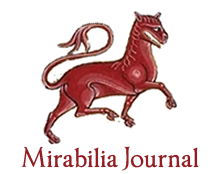The voice of women in the Libro de Apolonio
Carina ZUBILLAGA
Original title: La voz de las mujeres en el Libro de Apolonio
Published in Senses and sensibilities in classical and medieval worlds
Keywords: Female voice, Libro de Apolonio, Middle Ages, Sense of hearing.
The sense of hearing, which together with the sense of sight is associated with cognition in the Middle Ages, will be treated in this work based on the theme of the voice of women in the Libro de Apolonio, one of the representative texts of the Castilian “mester de clerecía”. The characters of Luciana and Tarsiana –wife and daughter of the protagonist Apollonius– sing, tell riddles and recite stories in numerous textual episodes that lets distinguish them as unique heroines with knowledge associated with the clerical culture of the Hispanic early thirteenth century. The study of the expressive and affective power of the female voice in these adventure stories is fundamental to highlight the tensions in the medieval vision about women, their sensitivity and the possibility of a singular voice.
The witness Queen. Jeanne d’Evreux in her Book of Hours
Ofelia MANZI, Patricia GRAU-DIECKMANN
Original title: La reina testigo. Jeanne d’Evreux en su Libro de Horas
Published in
Keywords: Book of Hours, Jeanne d’Evreux, Miniature, Politic iconography, St. Louis.
The Books of Hours produced in the late Middle Ages are a key plastic document for studying the iconography of the period. The multiplication of copies from the thirteenth century has given to the art of the Middle Ages some of the most interesting products in both formal and iconographic aspects. An additional element of interest of these works is the illustration developed in the margins, where figures and scenes are a sort of “parallel universe” in relation to the central theme of the respective folio. One of the most interesting works, not only for its extraordinary artistic level but also for its condition and original workmanship, is the tiny Book of Hours of Jeanne d’Evreux, third wife of Charles IV, who took on herself the responsibility and the final possibility of continuity of Capetian dynasty. In this manuscript some historical characters embodying an interpretative key are present. Two folios belonging respectively to the Hours of the Virgin and the Hours of St. Louis, have miniatures that testify a game between past and present, in which the contemporary history integrates with the biblical one, and demonstrate the value given to the image by its multiple possibilities of meaning.
Thought and Culture in Christian Egypt 284-641 AD. Cyril of Alexandria (412-444) and his patriarchic period according to Socrates Scholasticus
Eirini ARTEMI
Original title: Pensamiento y cultura en el Egipto cristiano 284-641 AD. Cirilo de Alejandría (412-444) y su período patriarcal según Sócrates Escolástico
Published in
Keywords: Christian Egypt, Culture, Cyril of Alexandria, Socrates Scholasticus, Thought.
Cyril of Alexandria (412-444) was not only one of the finest Christian theologians of his day, he also stands out in the ranks of the greatest patristic writers of all generations as perhaps the most powerful exponent of Christology the church has known. He brought great influence both in church life and in making the Christian teaching and especially in the formulation of Christological doctrine in the 5th century. For the life of the holy father, little is known. He was born between 370-380 AD Alexandria. The exact date of his birth we are not able to know it. He came from a wealthy family of the Greek city of Alexandria, although often the patriarch of Constantinople Nestorius calls him “Egyptian”, i.e. one who hails from Egypt, in order to taunt him. Nowhere was the divide more clearly seen in 415 CE than between Orestes, the Pagan Prefect of Alexandria and Cyril, the Archbishop of Alexandria, who lead the Christian mobs against the Jews of Alexandria, looted their synagogues and expelled them from the city. Orestes maintained his Paganism in the face of Christianity and cultivated a close relationship with Hypatia which Cyril, perhaps, blamed for Orestes' refusal to submit to the “true” faith and become a Christian. Tensions between the two men, and their supporters, grew increasingly high as each brushed off the other's advances of reconciliation and peace. His early life is known only from notices in Socrates Scholasticus and a few elsewhere. The latter explains the relations of Cyril of Alexandria with Orestes and Hypatia. Also, Socrates, although, was enemy to Cyril of Alexandria remains the most objective source for the life and actions of Cyril of Alexandria.
Three carmesinas real and one fictional. The interest in the dialogue between History and Literature for the interpretation of Tirant lo Blanc
Abel SOLER
Original title: Tres Carmesines reals i una de ficció. Interés del diàleg entre Història i Literatura per a la interpretació de Tirant lo Blanc
Published in
Keywords: Carmesina, Chivalric novel, Jaume de Vilaragut, Joanot Martorell, Tirant lo Blanc.
This article focuses on the historical Valencian knight and baron Jaume de Vilaragut (+ca. 1464), a friend from chilhood of Joanot Martorell, a devout reader of chivalric and Arthurian literature as well as of romances of materia Trojana. He married a member of the Martorell family, became a corsary and defender of Rhodes, was a prisoner of the Great Caramany and of the sultan of Babylon. He also resided at Naples together with the author of Tirant lo Blanc (1460-1464), and was a frustrated commander of the Crusade to recuperate Constantinople following the plan of Pope Calixtus III (1455). He could have been the inspiration for Tirant himself. This hypothesis is reinforces by the fact that there are three Carmesines from the mid-15th century associated with him: A Carmesina his "servant" and possibly his lover; Carmesina Requesens, his niece, born in the 1450s; and Carmesina de Corella, of whom he was godfather ca. 1452. The first Carmesina could have been the inspiration for the princess Carmesina of the chivalric novel.
Time, History, and Providence in the Philosophy of Nicholas of Cusa
Jason ALEKSANDER
Original title: Time, History, and Providence in the Philosophy of Nicholas of Cusa
Published in Nicholas of Cusa in Dialogue
Keywords: Divine Providence, Nicholas of Cusa, Philosophy of History, Temporality, Time.
Although Nicholas of Cusa occasionally discussed how the universe must be understood as the unfolding of the absolutely infinite in time, he left open questions about any distinction between natural time and historical time, how either notion of time might depend upon the nature of divine providence, and how his understanding of divine providence relates to other traditional philosophical views. From texts in which Cusanus discussed these questions, this paper will attempt to make explicit how Cusanus understood divine providence. The paper will also discuss how Nicholas of Cusa’s view of the question of providence might shed light on Renaissance philosophy’s contribution in the historical transition in Western philosophy from an overtly theological or eschatological understanding of historical time to a secularized or naturalized philosophy of history.
To be here and now. Study of the time and the space in the Viatge al Purgatori nomenat de Sant Patrici written by Ramon de Perellós i de Roda (c. 1350-1424)
Héctor ALAMINOS RAMIRO
Original title: Ser aquí y ahora. Estudio del tiempo y del espacio en el Viatge al Purgatori nomenat de Sant Patrici de Ramon de Perellós i de Roda (c. 1350-1424)
Published in Returning to Eden
Keywords: Medieval Time-Space, Purgatory, Ramon de Perellós.
This paper analyzes the temporal and spatial dimensions of the work of Ramon de Perellós referred to his journey to Saint Patrick’s Purgatory. Firstly, real, and imaginary-marvellous spheres are studied by separated to detach its meanings. Afterwards its contents are synthesized to obtain a panoramic view. Finally, these ideas are extrapolated to its historical context. By doing so, some conclusions are developed with the aim of connecting this work with the general transformations that take place in the Christian society of the medieval Western Europe.
Toward a didactic of Music in two Carolingian treatises: Musica and Scolica Enchiriadis
Julieta CARDIGNI
Original title: Hacia una didáctica musical en dos tratados carolingios: Musica y Scolica Enchiriadis
Published in Music in Antiquity, Middle Ages & Renaissance
Keywords: Didactic features, Discursive analysis, Musica Enchiriadis, Scolica Enchiriadis.
The present paper aims to analyze the didactic features present in two Carolingian writings about music: Musica and Scolia Enchiriadis, from 9th century. Traditionally transmitted and read together, these treatises contain some of the earliest medieval reflections on polyphony, modal theory, and musical training. In addition, Musica and Scolica Enchiriadis show how the Ars Musica turns into a performative notion, while still trying to be part –at least formally– of the tradition of speculative music and the harmonia mundi. In the context of the Carolingian reforms, Music seems to be acquiring a more practical dimension, according to the needs of homogenization of Liturgy accomplished throughout the Empire. This dimension, which of course had always existed as a performative aspect of Music, needs now to be theorized and systematized for its transmission. In his attempt to teach the –until then– oral knowledge about singing, the anonymous writer(s) of Musica and Scolica Enchiriadis needs not only to explain the new concepts, but also to create a common language to accomplish this task. The result of this intent is one of the first musical notation systems which, though not of great further impact as a means of transmission, gives us however a glimpse to the metalinguistic process of creating a musical language. Departing from Discourse Analysis, we will trace and analyze these didactic strategies and resources, with the purpose of delineating the didactic project of both treatises.
Tracing the Origins of Checkmate Patterns and Paths in Alfonso X’s Libro de los juegos
Sonja MUSSER GOLLADAY
Published in Games from Antiquity to Baroque
Keywords: Alfonso X the Wise, Checkmate Pattern, Chess, Libro de los juegos, Libro del acedrex, Retrograde Problem Analysis, Shatranj.
The present study interrogates Alfonso X’s bibliographic sources through his chess problems’ checkmates and move patterns.
Tradition and fashion in Greek costume
Miguel Ángel ELVIRA BARBA, Marta CARRASCO FERRER
Original title: Tradición y moda en el traje griego
Published in
Keywords: Cloack, Greek clothes, Peplum, Tunic.
All along the 6th and 5th centuries B.C., the clothes of the Greek women experienced though changes, which seem connected with the evolution of mind, cultural activity and some political events. We can sometimes talk about true “fashion” in the modern sense of the world.
Transactions from beyond life: wills with votes in favor of souls in Portuguese-Brazilian society in the crisis of the Ancien Régime (1700-1750)
Venceslau Tavares COSTA FILHO
Original title: Negócios do Além: testamentos em sufrágio das almas na sociedade luso-brasileira na crise do Antigo Regime (1700-1750)
Published in Returning to Eden
Keywords: Economy of Salvation, Inheritance Law, Social practices, Wills.
This article aims to discuss the use of wills with clauses on the suffrage of souls in the context of the economy of salvation in the first half of the 18th century in Brazil.






















































































